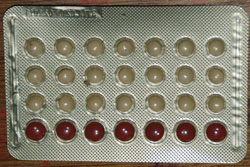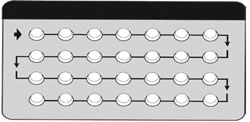Oral contraceptives and how they work
Based on their hormone content, oral contraceptives are divided into two types:
- combined oral contraceptives (COCs), which contain the hormones oestrogen and progesterone
- oral contraceptives with a single hormone, known as progestin-only oral contraceptives.
Combined oral contraceptives (COCs, OCs, and often just called the pill) are the most popular type of birth control. The term combined is used because they contain both oestrogen and progesterone hormones. There are many different brands, and they come in packs of 21 or 28 pills. One pill is taken every day. The first 21 pills have a combination of synthetic oestrogen and progesterone hormones. The last seven pills of a 28-day pack have no hormones and are called spacer pills. They are usually different in colour, and some brands contain iron. The iron in the pill can be taken as a supplement to avoid iron deficiency (figure below).

Progesterone-only (or progestin-only) oral birth control pills (or mini-pills) come in packs of 28 pills and women take one every day. They contain a synthetic form of the progesterone hormone called progestin, and no oestrogen (figure below).

Remember oral contraceptives do not protect against STIs or HIV/AIDS.
Neither combined, nor progesterone-only oral contraceptives, protect against sexually transmitted infections (STIs), including HIV/AIDS. If your client has or might get an STI, they should be given condoms to use regularly.
The pill works mainly by changing the body's hormonal balance so that the woman does not ovulate. That is, she does not release an egg (or ovum) each month from one of her ovaries. In addition, the pill causes the mucus made by the cervix to thicken and form a 'mucus plug' in the cervix which makes it difficult for sperm to get through to the uterus (womb) to fertilise an egg. The pill also makes the lining of the uterus thinner, which makes it unlikely that a fertilised egg will be able to attach to the uterus.